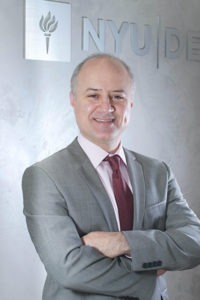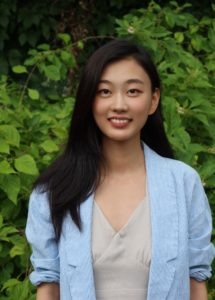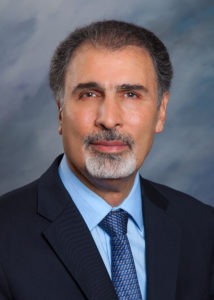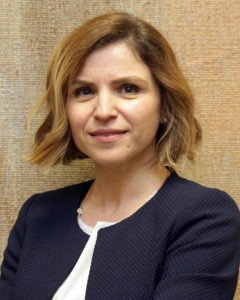2022 Winner’s Circle
Congratulations to the members of the 2022 Winner’s Circle!
Matthew Malek, DDS: Spring 2022 Highest Scoring Faculty Proposal
 Dr. Matthew Malek is the faculty winner of the Foundation for Endodontics Spring 2022 Competitive Research Proposal for his research on External Invasive Resorption titled: Potential Biological Markers of External Invasive Resorption in Saliva and Gingival Crevicular Fluid: A Pilot Study.
Dr. Matthew Malek is the faculty winner of the Foundation for Endodontics Spring 2022 Competitive Research Proposal for his research on External Invasive Resorption titled: Potential Biological Markers of External Invasive Resorption in Saliva and Gingival Crevicular Fluid: A Pilot Study.
“External invasive resorption is a disease of the tooth in which the immune cells surrounding the tooth attack tooth structure and eat through the tooth,” explains Dr. Malek. “The immune cells are not able to distinguish this natural structure, so it attacks the tooth as if it were a foreign tissue or structure. It’s very similar to an autoimmune process when the body attacks its own organs.”
Researchers have known about this pathological phenomenon for more than 100 years. Prior to that only two types of resorptions were known. However, current resources categorize 10 or more types of resorptions, along with some knowledge of their ideology, progression, pathogenesis and treatment outcomes.
Dr. Malek’s research focuses on investigating a less common, and less researched, type of resorption called external invasive resorption (EIR). As the largest dental school in the United States, with 22 post-graduate residents in their endodontic Program and a diverse patient pool, New York University’s program is host to a relatively high number of patients with this type of resorption.
Initial stages of his investigation involved collecting data for preliminary results and establishing proof of concept. The first arm of the study included comparing the biological markers in the gingival crevicular fluid (GCF) of a tooth with EIR to the markers of a healthy tooth in the same patient. From this Dr. Malek drew meaningful conclusions around the biological basis for this lesion and it was then that he submitted a grant application.
“We have two residents per year who work on this very involved research,” says Dr. Malek. “It requires recruitment of patients who all go through a series of diagnostic procedures and clinical testing and, if needed, radiography, scans and collecting saliva and the GCF.”
2022 was the first year in which his students were able to present the preliminary results at the AAE annual session, where they were awarded the 3rd place prize poster presentation, and Dr. Malek hopes they will complete the second stage of the project for presentation at AAE23.
“The first arm of the study included a cross-sectional review of patient records with the aim of finding an association between different patient factors involved in the incidence of this lesion. This arm also included investigating the amount of biological markers found in the GCF of a tooth with EIR compared to the a healthy tooth in the same patient,” explains Dr. Malek. “The second arm, which I am currently involved with, includes comparing various factors and the biological markers found in the saliva and GCF of patients presenting with an EIR lesion and a healthy patient. We have learned a lot about how the lesion behaves visually, whether it be microscopically or with micro scans, but something that has not been investigated much is the underlying biological components which drives this lesion, and those are molecules which could not be investigated with any imagery. It must be conducted through sampling and laboratory investigation. We are curious to know if there is anything in the biological markers that make a tooth or patient more vulnerable to this disease than others.
The third and last arm of the study is the prospective arm in which we follow up on these patients over the course of a year to see if the markers change from their original reading after they receive treatment. The result of this last stage will help us understand whether or not repairing these lesions affect the activity or progression of the disease at a molecular level.”
There are a few variables that determine the treatment modality.
“One is the size of the lesion, which can only be determined accurately via a cone-beam computed tomographic (CBCT) image. Larger sized lesions are better left alone and monitored or extracted,” he explains. “The other variable is the location of the lesion on the tooth, which also determines accessibility. Combined, these variables determine whether internal – in conjunction with a root canal treatment or external – or in conjunction with surgical or non-surgical procedure, is a viable option. New technologies, such as the laser and the GentleWave, has made it possible to successfully treat many of these cases internally.”
Dr. Malek also emphasizes the need for incorporating current knowledge on different types of resorptions to dental education. Many of these lesions are not diagnosed in a timely manner because their progression is asymptomatic and, at their initial stages, can radiographically resemble a normal tooth anatomy. So, they are generally undetectable by an untrained eye until their later stages of growth, at which time are usually untreatable. He believes that the knowledge and skills for detecting these lesions must be fostered at the dental school level, as general dentists usually have the most potential to detect these lesions radiographically. He also points out that there are currently no standard diagnostic steps to evaluate and document EIR. Evaluating these lesions requires additional diagnostic and evaluative processes. For example, there is evidence that EIR can be associated with poor oral hygiene or parafunctional habits. As an endodontist one is usually not concerned with these findings, but Dr. Malek posits that they should be included as part of dental diagnostic steps in patients with EIR.
Patient education is another aspect of his research.
“This type of lesion destroys the tooth from the inside, so a completely healthy-looking tooth may, in fact, be hopeless and that is not always easy to explain to the patient,” he says. “I sometimes show my patients radiographs of their advanced stage EIR. It is mind blowing for them to see that a seemingly healthy tooth can be almost hollow, with only a shell outside.”
Dr. Malek received his dental training in Iran and practiced general dentistry there for five years.
“At that time my interest was attending the medical school, but nevertheless I ended up in dentistry,” he remembers. “ From the start I had been looking for an opportunity to move from general dentistry and into a specialty.”
He moved to the United States in 2004, where he recredentialed for a second DDS degree.
“As a general dentist in Iran I had to do many root canals, and I did not understand why so many of them failed. After moving to the United States and being exposed to various specialties, I realized that it was time to leave general dentistry and pursue a specialty program, and my first choice was to be trained in a field in which I was weakest: endodontics,” Dr. Malek recalls. “I also knew that I wanted to become an educator. So, immediately after graduation, I joined NYU as full-time faculty at the post-graduate level, and as an endodontist and an educator, and I have enjoyed my career even more ever since.”
Dr. Malek feels fortunate to be able to balance his endodontic practice with teaching at NYU and continuing research. He is also grateful for inspiring mentors over the years and the opportunities he has been given.
“I owe all this to many people, to every single person that helped me get to the place where I am today,” says Dr. Malek, who thanks the Foundation for recognizing the importance of his research.
“Being an educator has been one of the most fulfilling aspects of my career. I often tell my students, ‘In our program, you come in, but you never leave. It’s a lifetime program in which we provide support, even after graduation.’” he says. “I love to see how my students grow and become successful, and my goal is to make them feel that they are now part of a bigger family.’
Dr. Malek enjoys outdoor activities such as hiking, often with his students, spending time with his family and playing music.
Dr. Malek is a Diplomate of the American Association of Endodontics, the Director of the Advanced Education Program in Endodontics at NYU, and practices endodontics in private practice in Manhattan, New York. He received his certificate in the specialty of endodontics from NYU Dentistry in 2011 and was appointed to full-time faculty immediately after graduation, a position which he still holds. Dr. Malek is the author/co-author of several peer-review articles and chapters in prominent endodontic journals and textbooks.
Sally Liu, DDS: Spring 2022 Highest Scoring Resident Proposal
 Dr. Sally Liu earned her dental degree from the University of Toronto, Canada and is currently a resident at the University of Alabama at Birmingham. Her research topic, Relative Efficacy of Innovative Endodontic Antimicrobial Agents, focusing on the disinfection portion of root canals, was awarded the highest score for the Spring 2022 Resident Competitive Research Grant.
Dr. Sally Liu earned her dental degree from the University of Toronto, Canada and is currently a resident at the University of Alabama at Birmingham. Her research topic, Relative Efficacy of Innovative Endodontic Antimicrobial Agents, focusing on the disinfection portion of root canals, was awarded the highest score for the Spring 2022 Resident Competitive Research Grant.
“Usually root canal treatment or regenerative endodontics is divided into the mechanical and chemical portion of cleaning the bacteria, as bacterial infection is the main cause of the disease,” states Dr. Liu. “My research focuses on the chemical portion of effective disinfection of the whole system to help improve outcomes for the patient.”
Dr. Liu is testing a new antimicrobial agent, Analogue #66, that could potentially become an alternative to the traditional intracanal medicament, calcium hydroxide. The long-term goal of her research is to identify a novel medicament with better disinfectant abilities, more specific targeting mechanism against resistant biofilms, and more predictable disinfection results.
Mahmoud Torabinejad, DMD, MSD, PhD: Fall 2022 Highest Scoring Faculty Proposal
 Dr. Mahmoud Torabinejad’s primary interest in endodontics lies in its biological aspects as they relate to clinical practice. His recent protocol, Differentiation of Soft and Hard Dental Tissues in a Ferret Model: MRI Characterization with Histologic Confirmation: A Pilot Project, was awarded and ranked the highest scoring faculty proposal for fall 2022.
Dr. Mahmoud Torabinejad’s primary interest in endodontics lies in its biological aspects as they relate to clinical practice. His recent protocol, Differentiation of Soft and Hard Dental Tissues in a Ferret Model: MRI Characterization with Histologic Confirmation: A Pilot Project, was awarded and ranked the highest scoring faculty proposal for fall 2022.
Dr. Torabinejad’s almost 50-year career as an endodontic researcher began with his focus on pulpal, periapical, inflammation and immunology. He applied those principles to the successful development and use of the mineral trioxide aggregate (MTA) for various procedures such a vital pulp therapy, apexification, regenerative endodontics, perforation repair, root end and root canal filling. MTA also proved to a valuable fundraising tool for the Foundation.
Pulp regeneration is not a new idea. In fact, it is an old concept that, with the development of new technology, has seen a resurgence of interest. Based on many animal and a few human studies it appears that the currently used protocols do not lead to regenerating pulp tissue but to the formation of hard tissues in the root canals, instead. Because of uncertainty regarding the nature of tissues developed using current protocols, some endodontists use previous methods for treating teeth with necrotic pulps and open apexes.
Dr. Torabinejad’s current research proposal details using non-invasive, high-resolution MRI in ferret teeth to discover new information regarding the nature of tissues following regenerative endodontics.
“The only way to discover the nature of tissues formed after using regenerative endodontics is to extract the tooth, section it and do histology on it,” says Dr. Torabinejad, who hopes to replace that long standing gold standard with processes based on his research findings. “If the MRI findings are very close to what we find with histology, then this technique opens up a big area of research for diagnosis, treatment planning and prognosis of pulpal and periapical diseases without using ionizing radiation or histology.”
If there is a close correlation between histologic and MRI findings then it would be possible to use this technique in experimental animals without sacrificing them, which would improve animal research significantly. In addition, the this technology has the potential to expand areas of investigation for the advanced endodontic students and faculty members around the world.
Dr. Torabinejad extends his thanks to the Research & Scientific Affairs Committee, the Foundation and its Trustees. He particularly thanks the AAE members whose donations to the Foundation of Endodontics have made it the envy of other dental specialties. He is proud to have participated in a restructuring of the Foundation that has driven growth, development and increased funding for research and education through more reliance on fellow endodontists and AAE members.
Dr. Torabinejad believes that the generosity of members and corporations has made the Foundation the backbone of the AAE. The commitment of specialists to increasing research opportunities for their colleagues has enabled the Foundation for Endodontics to supported and fund research grants and training of endodontic educators at various institutions.
“There are people who think endodontics is just a technique-oriented procedure that only deals with cleaning the obturations of root canals and should not be even a specialty,” Dr. Torabinejad says, adding that this limited view of the specialty is problematic. Instead, endodontics is both art and science. “You can program a robot or train a highly intelligent animal to do the ‘how’, but you cannot program or teach them the art. That is the difference between a mere clinician and a genuine, well-trained endodontist.”
Dr. Torabinejad sincerely believes a healthy mind can be present only in a healthy body. He was the captain his dental school’s volleyball team and continues to exercise and enjoy sports, including American football, basketball and volleyball—and always routing for the underdogs.
He is president and director of the Endodontic Institute of Surgical Education and Research Venues, a professor of endodontics and former Director of the advanced specialty education program in endodontics at Loma Linda University (LLU) School of Dentistry. Currently, he is an adjunct professor at LLU, University of Pacific in San Francisco, University of California in San Francisco, Dean’s professor of endodontics at the University of Maryland, Research professor at the University of Minnesota and affiliate professor of endodontics at the University of Washington in Seattle. He is the author of eight textbooks and had contributed to more than 350 publications. He is the #1 source of citations in classic articles in the fields of endodontics and pulp regeneration. He has presented over 250 lectures in over 40 countries, received numerous awards throughout his career, and is a past president of the California Association of Endodontics, the AAE and its Foundation.
Hacer Aksel, DDS, PhD: Fall 2022 Highest Scoring Resident Proposal
 Dr. Hacer Aksel’s highest scoring research proposal, Effect of Matrix Metalloproteinase-9 on Cellular Functions and its Sensitivity to N-Acetylcysteine (NAC), focuses on regenerative vital pulp therapies. This project is a collaborative project with Dr. Keith Kirkwood, Senior Associate Dean for Research, periodontist, and leading scientist in oral immunology at University at Buffalo. In this project Dr. Aksel wants to explore new biomaterial approaches to achieving predictable pulp and dentin tissue healing in the treatment of deep caries in permanent teeth with vital pulp.
Dr. Hacer Aksel’s highest scoring research proposal, Effect of Matrix Metalloproteinase-9 on Cellular Functions and its Sensitivity to N-Acetylcysteine (NAC), focuses on regenerative vital pulp therapies. This project is a collaborative project with Dr. Keith Kirkwood, Senior Associate Dean for Research, periodontist, and leading scientist in oral immunology at University at Buffalo. In this project Dr. Aksel wants to explore new biomaterial approaches to achieving predictable pulp and dentin tissue healing in the treatment of deep caries in permanent teeth with vital pulp.
“Clinical interventions for dental caries, which is the most common health problem worldwide, range from simple fillings to the more invasive root canal treatment,” states Dr. Aksel. “Vital pulp therapy is a minimally invasive approach to treat deep caries of the vital teeth while maintaining dental pulp vitality and inducing mineralized tissue formation. Preserving the pulp vitality will not only maintain the biological functions of the dental pulp but also result in higher mechanical strength and reduce the risk of fracture. If root canal treatment can be prevented or postponed, the longevity of the tooth will most likely be improved.”
Currently, the health status of dental pulp cannot be evaluated in a clinical setting using traditional clinical tests unless the pulp is removed and studied histologically.
“Significant effort has been made to identify a biological marker to predict the inflammatory status of the dental pulp and its healing capacity,” says Dr. Aksel. “Matrix Metalloproteinase-9 (MMP-9) is one of these markers involved in the pathogenesis of pulpal disease.”
Previous studies have shown that vital pulp therapies are ineffective when a high concentration of MMP-9 is found in the cariously exposed pulp. On the other hand, MMPs are needed to regulate different cellular activities during tissue healing. Conducting basic scientific research on the effect of these biomolecules on cellular functions can provide translational data to optimize the treatment protocol and biomaterial to enhance the healing response after vital pulp therapies. This project will explore changes in the cellular functions in MMP-9-induced inflammatory condition and modulation of the cellular functions using an anti-inflammatory agent (NAC) loaded in a gelatin-based three-dimensional hydrogel matrix.
Dr. Aksel’s research will provide a basis for designing a new approach and treatment modality for vital pulp therapies. Her project’s long-term goal is to explore immunomodulatory hydrogel-based biomaterial to resolve pulpal inflammation while maintaining cellular functions to repair and regenerate the pulp-dentin complex during the treatment of deep caries. Findings from this work will provide a solid foundation for future translational studies to improve the predictability of vital pulp therapies and allow practitioners to apply them in clinical practice more confidently. Furthermore, this novel approach may open new avenues to treat other MMP-associated inflammatory diseases such as arthritis.
Upon receiving a fellowship grant from the Turkish government (TUBITAK), Dr. Aksel completed a one-year fellowship at the University of Tennessee Health Science Center, Department of Bioscience Research in 2014. Her mentor, Dr. George Huang, is one of the pioneers in the field of regenerative endodontics. Dr. Aksel completed a clinical-research program, receiving her Ph.D. at Hacettepe University in Turkey with a specialty in Endodontics in 2016. Dr. Aksel joined the University at Buffalo School of Dental Medicine in 2018, where she created a cell culture lab with faculty funding and the support of the Department of Periodontics and Endodontics. She has conducted research projects on root canal sealers and regenerative endodontics and has since begun an endodontic residency to become board-eligible.
“I see myself as a lifetime learner, trying to improve my knowledge and skills in endodontics and interdisciplinary areas such as immunology, tissue engineering, biomaterials, and biostatistics,” says Dr. Aksel. “I mentor my students and learn from them, also. Now that I’m in my residency, my students who became second-year students are now teaching me. This is a very unique experience for me and I really enjoy it,”
Dr. Aksel loves spending time playing with her 5-year-old son, cooking, sharing her experiences with friends and family, visiting her hometown in Turkey, and exploring new places and cultures.
The Foundation has supported Dr. Aksel’s research projects, helping her to continue her research in regenerative treatment while mentoring endodontic residents at University at Buffalo. These research projects will lead to the development of functional hydrogel systems in the regenerative process in combination with infection and inflammatory control, ultimately filling the large knowledge gap in this unique area.
Dr. Aksel believes that ongoing research funded by the Foundation will enable the department to establish interdisciplinary collaborations for high quality translational basic science research in regenerative endodontic treatments.




